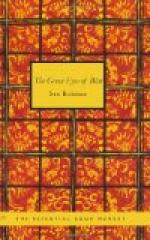“The fetes of Bast attracted pilgrims from all parts of Egypt, as at the present day those of Sidi Ahmed el-Bedawee draw people to the modern fair of Tantah. The people of each village crowded into large boats to get there, men and women pell-mell, with the fixed intention of enjoying themselves on the journey, a thing they never failed to do. They accompanied the slow progress of navigation with endless songs, love songs rather than sacred hymns, and there were also to be found among them flute-players and castanet-players to support or keep time to the voices. Whenever they passed by a town they approached the bank as near as they could without landing, and then, while the orchestra redoubled its noise, the passengers threw volleys of insults and coarse remarks at the women standing on the banks; they retorted, and when they had exhausted words ...”
I finished my notes at this point; the improper behavior of the Ancient Egyptians mentioned by the great Egyptologist having no possible bearing upon the matter in hand, I thought. I then proceeded to add some facts directly relating to the votive offerings laid at the feet of the goddess.
“The greater number of pilgrims, before returning home, left a souvenir of their visit at the feet of Bast. It was a votive stele with a fine inscription, and a picture showing the donor worshiping his goddess; or a statuette in blue or green pottery, or if they were wealthy, in bronze, silver, or sometimes gold: the goddess would be standing, seated, crouching, with a woman’s body and a cat’s head, a sistrum or an aegis in her hand. During the Greek period the figures were in bronze or in painted or gilded wood surmounted by a cat’s head in bronze, many were life-size and modeled with elaborate art; they had eyes of enamel and amulets on the forehead.”
The learned authority went on to explain that these accumulated offerings were after a time stored by the priests in cellars or in pits dug expressly for them, “veritable favissae similar to those of classical times.” They accumulated in thousands, large and small, some intact and fresh as when just made, others already out of shape and of no value. The places of concealment were soon forgotten, and the stores hidden therein reposed beyond the reach of men until the day when the chances of excavation brought them to light.
My notes completed, I turned my attention to the little image of green enamel ware which Gatton had left with me for examination. It was not possible to determine the period at which it was buried, but judging from the contours and general forms, together with the aspect of the enamel, I thought I recognized the style of the second Saite Period, and attributed the piece to the early Ptolemies, or the fourth century B.C. It was the time when the worship of Bast and her subordinate forms, Pakh, Mait, was most popular, the period when the most extensive cemetery of cats was established in Egypt. The execution of the little figure was pure Egyptian, and in no way betrayed Greek influence.




